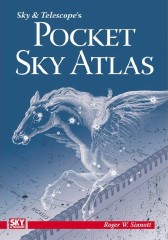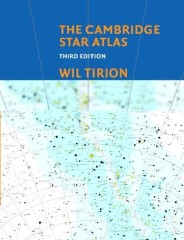Review: Two Inexpensive Star Atlases
Sky and Telescope’s Pocket Sky Atlas
by Roger W. Sinnott
Sky Publishing, 2006. Coilbound, 124 pp. ISBN 1-931559-31-7
The Cambridge Star Atlas, Third Edition
by Wil Tirion
Cambridge University Press, 2001. Hardcover, 96 pp. ISBN 0-521-800846
 Rod Mollise’s recent look at star atlases (see previous entry) reminded me that I’ve been meaning to review a couple of star atlases in my possession. They are Wil Tirion’s Cambridge Star Atlas, the third edition of which came out in 2001, and Sky and Telescope’s Pocket Sky Atlas. Both feature beautiful, sharp, black-on-white cartography and neither is particularly expensive — and, in their relative strengths and weaknesses, they complement each other well. While I’m hardly an experienced astronomer, I do enjoy looking through my telescopes as often as I can, and can say a few things about how these two atlases have helped my observations.
Rod Mollise’s recent look at star atlases (see previous entry) reminded me that I’ve been meaning to review a couple of star atlases in my possession. They are Wil Tirion’s Cambridge Star Atlas, the third edition of which came out in 2001, and Sky and Telescope’s Pocket Sky Atlas. Both feature beautiful, sharp, black-on-white cartography and neither is particularly expensive — and, in their relative strengths and weaknesses, they complement each other well. While I’m hardly an experienced astronomer, I do enjoy looking through my telescopes as often as I can, and can say a few things about how these two atlases have helped my observations.
I started with Sky and Telescope’s Pocket Sky Atlas by Roger W. Sinnott; because of its small size and coil binding, I’ve found it to be quite useful in the field. It depicts stars down to magnitude 7.6, which according to the introduction covers stars visible in a finderscope; I don’t have a finderscope (I use red-dot finders) so I can’t evaluate that; it also includes double stars, galaxies, globular clusters and nebulae that could reasonably be expected to be visible in a small telescope. This is, in other words, to be an an amateur astronomer’s working star atlas, and it largely succeeds.
The Pocket Sky Atlas contains 80 main plates — the sky is divided into 10 gores, with 10 plates per gore. Plates at the celestial equator roughly 40 degrees of declination and 90 minutes of right ascension, at a scale of roughly five degrees to 24 mm. (There are also close-up charts for some obvious areas of interest: the Pleiades, the nebulosities in Orion, the galaxy cluster in Virgo and Coma Berenices, and the Large Magellanic Cloud.) There’s always oodles of overlap, which is handy, but it’s a hard atlas to browse. That’s partly because of the book’s small size and the charts’ large scale, which are assets in every other way. But browsing from plate to plate is problematic, because within each gore the plates proceed from north to south, which forces me to turn past a lot of southern hemisphere charts to get to the next plate east or west.
The Pocket Sky Atlas’s weaknesses are the Cambridge Star Atlas’s strengths. And vice versa: a hardbound atlas that only goes to magnitude 6.5 is of limited use at the scope (Mollise himself doesn’t recommend this class of atlas as a result). But it’s the right magnitude for naked-eye visual observations, and its small-scale charts have really helped me figure out where everything is in relation to everything else. So they’re complimentary in that respect: I can use, for example, the Cambridge to plan my observing evening at home, and take the Pocket with me when I take the telescope out to my observing field.
The Cambridge Star Atlas is divided into three parts: a series of monthly sky maps (the sort you’d see every month in Astronomy or Sky and Telescope, or on a planisphere), the star charts themselves, and a set of all-sky maps in the Mollweide projection showing the distribution of clusters, galaxies and nebulae. The star charts are the meat of the book, and what make it worth getting; facing each chart is a list of points of interest — variable and double stars, clusters, nebulae, galaxies — along with their locations and magnitudes. At a glance, I can tell what’s nearby and, thanks to their magnitude, whether I should try and look for it. (A magnitude-18 planetary nebula, for example, is clearly beyond the possibilities of my five-inch Schmidt-Cassegrain.)
One practical shortcoming of the Cambridge is that so few stars are actually named in the charts. I don’t mean obscure stars that happen to have old Arabic names; we’re talking Bellatrix and Rasalhague, the stars of the Big Dipper, and well-known observers’ targets like Albireo, all of which are only labelled with a Greek letter. In an era of computerized telescopes that ask you to sync your telescope from an alphabetical list of bright stars, such names would be extremely helpful. I hope the fourth edition includes them (this 2001 edition likely predates the widespread use of go-to scopes).
These are by no means the only star atlases out there; other, more experienced observers will have their own preferences. I’ve just scratched the surface, and expect to encounter more of them as I mess around with astronomy some more. But so far I like what I’ve seen.
- Buy The Cambridge Star Atlas, Third Edition at Amazon.com
- Buy Sky and Telescope’s Pocket Sky Atlas at Amazon.com


Comments
blog comments powered by Disqus